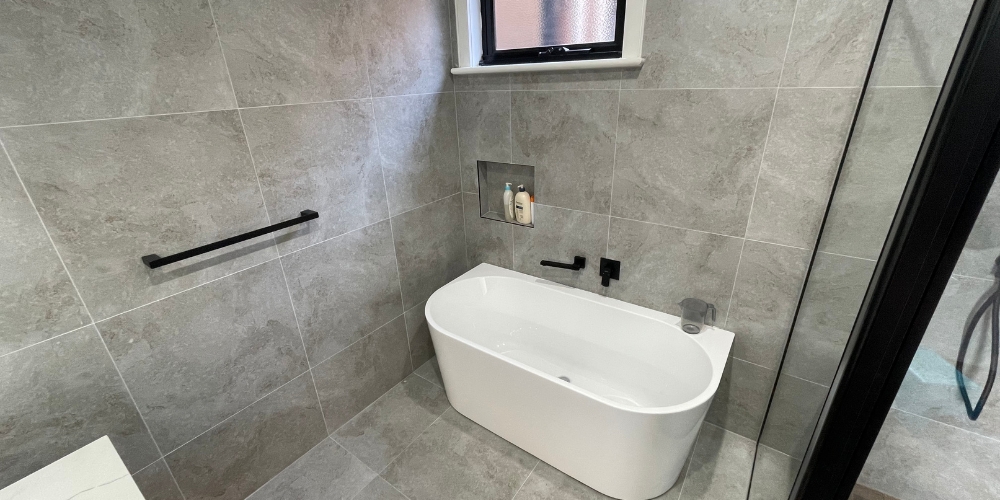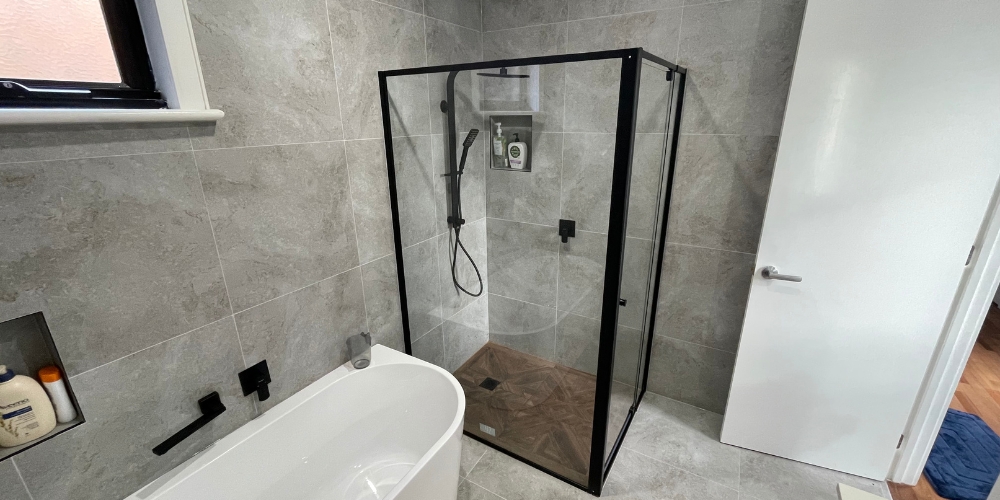Where Do Your Start When Redoing a Bathroom?
Reading time: 4 min 49 sec

Chadi
We understand that renovation projects are overwhelming. From planning and brainstorming ideas to wanting those Pinterest-perfect designs and staying within your budget… It can feel like a lot to handle, right?
Renovating a bathroom is no different. The truth is, we would hear clients feel more overwhelmed with renovating bathrooms than their rooms!
But fear not because we’re here to simplify the process for you. With over 20 years of experience renovating bathrooms in Melbourne, we know how to make your vision a reality without the stress. Step by step, let’s dive into the proper order of bathroom renovation.
When Do You Usually Need a Bathroom Renovation?
If you ask this question, you might be already seeing signs that its time time for your bathroom renovation. Additionally, if you’re feeling uninspired or dissatisfied with the overall look and feel of your bathroom, it’s a good time to consider refreshing the space with a renovation.
Let’s delve into these signs a bit deeper:
Outdated Fixtures and Finishes:
Do the taps in your home drip constantly? Do your tiles have an old-world feel to them? Not only can outdated finishes and fixtures take away from the overall beauty of your bathroom, but they can also be a sign of possible practical problems.
Functional Issues and Safety Concerns:
Do you need help with leaky plumbing or insufficient lights all the time? Functional problems like inadequate lighting, leaky water, or ventilation make you uncomfortable and dangerous.
Lack of Storage and Organisation:
Are your toiletries everywhere in your bathroom? A tiny, disorganised bathroom is less functional due to insufficient storage and organisation.
Changing Lifestyle Needs and Preferences:
Has your family expanded, or have your tastes in living changed over time? Whether adding accessibility features for elderly family members or installing a bathtub for relaxation, your bathroom should adapt to your changing needs and preferences.

Assessment and Planning
- Evaluate your current bathroom layout and identify areas that need improvement.
- Consider factors such as functionality, aesthetics, and any specific requirements you have.
- Create a detailed plan outlining your renovation goals, including the fixtures you want to replace, the style you aim for, and your budget constraints.
- Take space measurements to ensure that your new fixtures will fit properly.
Demolition
With your plan in hand, it’s time to roll up your sleeves and start tearing out the old elements of your bathroom. Remove the existing fixtures, such as the toilet, vanity, bathtub, and shower, and any outdated flooring and wall coverings. Use appropriate tools and techniques to dismantle these components carefully, being mindful of any underlying plumbing or electrical systems.
Plumbing and Electrical Work
- Once the old fixtures are removed, assess the condition of the plumbing and electrical systems.
- Check for leaks, corrosion, or outdated wiring that may need attention.
- If necessary, hire a licensed plumber and electrician to make any repairs or upgrades to ensure that your new fixtures will function properly and safely.
Structural Work
If you’re planning to make significant changes to the layout of your bathroom, such as moving walls or adding windows, now is the time to do so. Work with a professional contractor to handle structural modifications, ensuring they are completed according to building codes and regulations.
Installation of New Fixtures
With the plumbing, electrical, and structural work completed, it’s time to install your new fixtures. This includes setting up the toilet, vanity, bathtub, shower, faucets, and lighting fixtures according to your design plan. Follow the manufacturer’s instructions carefully to ensure proper installation and functionality.
Flooring and Wall Finishes
- Once the fixtures are in place, focus on the flooring and wall finishes.
- Choose aesthetically pleasing and practical materials for a bathroom environment, such as ceramic tile, vinyl flooring, or waterproof laminate.
- Install the flooring and wall coverings precisely, paying attention to detail to achieve a polished look.
Finishing Touches
- Add the final touches to your newly renovated bathroom to enhance its functionality and style.
- Install towel racks, shelves, mirrors, and other accessories to maximise storage and convenience.
- Add decorative elements like artwork, plants, or textiles to personalise the space and create a welcoming atmosphere.
Final Inspection and Clean-Up
- Before considering your renovation complete, thoroughly inspect the entire bathroom to ensure everything is in order.
- Check for any loose fixtures, leaks, or other issues that must be addressed.
- Once satisfied with the results, clean up any debris or mess left behind from the renovation to reveal your beautiful new bathroom in all its glory.

The Things You Need To Know Before a Bathroom Renovation
With all the steps we provided above, renovating a bathroom is seems to be easy and straightforward.
But let me tell you: there are several important things you need to know before diving into a bathroom renovation.
Planning for Disruption
Your regular schedule may be disturbed by bathroom renovations, particularly if it’s the only bathroom in your house. Anticipate brief inconveniences, including restricted restroom access and elevated dust and noise levels. If you have no other plans, consider staying with friends or family or using your neighbour’s bathroom while renovating.
Budgeting Realistically
Renovating a bathroom can be costly, and unexpected expenses can quickly increase. Establishing a realistic budget upfront and allocating funds for the expected costs (such as materials and labour) and potential unforeseen expenses (such as plumbing or electrical issues) is crucial.
How much does a bathroom renovation would typically cost?
| Renovation Type | Description | Cost Range |
|---|---|---|
| Minor Renovation | Small updates like replacing fixtures, tiles, or paint. | $8,000 - $15,000 |
| Mid-Range Renovation | Extensive renovation including fixture replacements, plumbing and electrical updates, new flooring, and custom features. | $15,000 - $25,000 |
| High-End Renovation | Involves high-quality materials, luxury fixtures, custom cabinetry, and intricate tile work. | $25,000 - $35,000+ |
Disclaimer:The cost ranges mentioned are rough estimates and can vary depending on where you are, what you want to do, and your personal preferences. Before diving into your renovation project, it’s wise to get detailed quotes and consider any extra expenses that might pop up along the way.
I’ve addressed this common question in a blog, but to provide a ballpark figure, a bathroom renovation often ranges from $8,000 to $35,000 or more. The final cost depends on various factors, such as the size of the bathroom, the quality of materials used, the extent of the renovation, and the location.
Additionally, labour expenses, permits, and unexpected costs can impact the total expenditure. Proper planning and budgeting are essential to ensure that your renovation aligns with your financial resources. Seeking quotes from reputable contractors and comparing material prices can help you estimate costs more accurately for your specific project. Remember, while a bathroom renovation is an investment, it can significantly enhance both the functionality and value of your home in the long term.
Understanding Your Limits
While DIY renovations can be tempting to save money, knowing your limits and recognising when to call in the professionals is essential. Some tasks, such as plumbing or electrical, require specialised skills and knowledge. Attempting these tasks without proper expertise can lead to costly mistakes and safety hazards.
Considering Functionality
Remember that practicality is as important as beauty when organising your bathroom remodel. Given your regular usage of the area, prioritise amenities that will increase your comfort and convenience. This could entail adding storage options, enhancing the lighting, or rearranging the space to create a more efficient flow.
Selecting Quality Materials
Prioritise quality over cost when selecting materials, finishes, and fixtures for your bathroom renovation. High-quality materials will increase your bathroom’s overall aesthetic appeal and extend its lifespan and durability. Seek materials that can sustain regular wear and tear, are moisture-resistant, and are simple to clean.
Obtaining Necessary Permits
The extent of your remodelling job may require you to apply for permission from the local building authority. Make sure your renovation plans adhere to building standards and laws before beginning any work, and find out what your area’s permit requirements are. Delays and expensive fines may arise from needing to obtain the required permissions.
Frequently Asked Questions
Finalising the renovation plan before work begins is best to avoid delays and additional costs. However, if changes are necessary, discuss them with your contractor promptly and be prepared for potential adjustments to the timeline and budget.
Coordinate with your contractor to establish a schedule for bathroom access during the renovation. Consider setting up a temporary portable toilet or shower outside the home, and communicate your needs and concerns with your contractor to minimise inconvenience.
Communicate your preferences, ideas, and desired outcomes with your contractor or designer. Please provide them with inspirational images, sketches, or a mood board to convey your vision effectively.
Clear out any items from the bathroom and adjacent areas to create space for the renovation work. Protect floors and furniture with drop cloths or plastic sheeting to prevent damage from dust and debris.
Conclusion
Renovating your bathroom is more than just making it look pretty—it’s about making it work better for you and your home. Remember to plan carefully, stick to your budget, and get help when needed.
As someone who knows about renovations, I suggest you take your time and do things right. Don’t be afraid to ask questions; ensure you use good materials.
Now that you know what to do, it’s time to start! Whether you want a fancy spa or just a better bathroom for your family, we’re here to make it happen. Reach out to us today, and let’s turn your bathroom dreams into reality!
Like this article?
